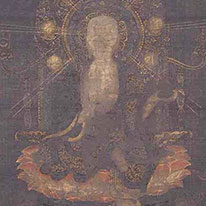Past Exhibitions
- The Bodhisattva Jizō (Kṣitigarbha) and the Ten Kings of Hell
- June 12, 2018 - July 8, 2018
The deities shown here for centuries filled Japanese viewers both with fears of going to hell (Ten Kings) and with hopes for redemption (Jizō). Japanese beliefs about hell reflect the path of Buddhism from South Asia, where Buddhism began, through China, and into Japan.
In India, services to the dead were traditionally conducted every seven days for seven weeks. (In Japan today, the typical period of mourning is still 49 days.) In China, those practices were combined with Confucian funerary rituals, resulting in the worship of the Ten Kings—fierce deities who judge the dead and decide their fate in the afterlife.
In Japan, Indian and Chinese beliefs were combined with the worship of Jizō, a bodhisattva who looks like a Buddhist priest. Jizō was seen as a savior who could rescue people fallen into hell—a sort of alter-ego of the fierce King Enma, ruler of the Ten Kings. This is why Jizō and the Ten Kings are so closely related in Japanese Buddhism.












